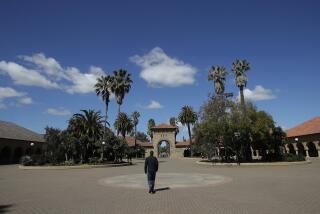Affirmative Action and Society
Re “House of Cards for Black Law Students,” Commentary, Dec. 20: UCLA law professor Richard Sander’s research and his plea for “a more measured debate” on affirmative action might lead some to call for its prohibition. That would be the wrong course to take.
Public policy decisions governing higher education admissions require more searching inquiry with a thorough consideration of the roles of universities and law schools, especially publicly funded ones, to serve and raise all communities.
Earlier this year, the Discrimination Research Center examined the impact that Proposition 209’s ban on affirmative action had on women in construction trades in California. Proposition 209 proponents had touted the repeal of affirmative action requirements on local and state public contracting as a better way than affirmative action to advance women and racial minorities.
The DRC report found that the slow but steady prior increase in women’s representation in carpentry, electrical and plumbing jobs and apprenticeship programs stopped after Proposition 209 was enacted. Men, on the other hand, increased both their numbers and percentage of the blue-collar workforce.
Whether the steps taken backward by tradeswomen necessarily portend the same result for African American law school applicants in a post-affirmative action world remains to be seen.
Nonetheless, enhancing student support programs rather than walking away from efforts to open doors to higher education better reflects a broad national consensus that the nation as a whole benefits with increases in minority attorneys, doctors, teachers and other professionals.
Achieving that goal requires serious and thoughtful discussion and then action by friend and foe of affirmative action alike.
John D. Trasvina
Western States Regional
Director, U.S. Commission
on Civil Rights
Los Angeles
*
Sander’s study of law school affirmative action is deeply flawed for many reasons, but there are a couple of significant ones not addressed in Goodwin Liu’s commentary (“A Misguided Challenge to Affirmative Action,” Dec. 20).
First, Sander claims that more than “85% of blacks admitted to law schools today” would still be admitted without affirmative action. However, since 2001, the year he relies upon, law school admission has become much more competitive because of the soft job market.
Thus, replicating Sander’s model for the 2004 admissions cycle shows that less than 68% of African Americans would still be admitted were affirmative action ended nationwide. And because of several questionable assumptions in Sander’s model, the overall impact would likely be significantly worse.
Second, if the true culprit is affirmative action “mismatching” black students at law schools where they are set up for failure, why is it that within Sander’s main data set, among African Americans with the same entry credentials, attending higher-ranked law schools is consistently associated with higher graduation rates and higher bar passage rates? Readers can judge Sander’s study for themselves by reading a draft of my critique with leading social scientists and law professors, forthcoming in the Stanford Law Review.
William Kidder
Researcher
Equal Justice Society
San Francisco
*
Neither Sander nor Liu state the core of the issue: Giving more points on entrance applications due to skin color is unfairly biased in itself. Applicants should gain entrance only on merit and hard work, not on things they cannot control like skin color.
If students are not accepted because there are more qualified applicants, they accept that. Once students are accepted, it is up to them to succeed, no matter what tier the school is on. Besides, students go to school to learn and become successful, not because they want a forced diverse society.
Bob Petersen
Little Canada, Minn.
More to Read
Get the L.A. Times Politics newsletter
Deeply reported insights into legislation, politics and policy from Sacramento, Washington and beyond. In your inbox three times per week.
You may occasionally receive promotional content from the Los Angeles Times.










